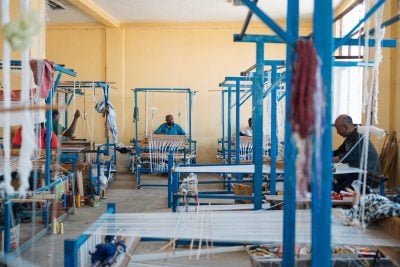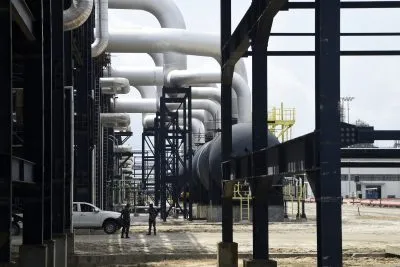In a factory outside Kigali, dozens of workers are putting the finishing touches to electric motorcycles that will soon take to the streets of the Rwandan capital. The bikes, built by startup Ampersand, are destined mainly for motorcycle taxi operators and delivery drivers, who can make significant savings by using battery-powered vehicles rather than paying for petrol or diesel.
Alp Tilev, co-founder and chief technical offer at Ampersand, says that the company wants to carry out as much manufacturing “as feasibly possible” in Rwanda. “We’re creating an ecosystem here – and you just can’t create an ecosystem if everything is just being brought in and sold,” he says. “The value chain needs to develop locally if we are to stay ahead.”
Ampersand is one of several companies seeking to kickstart the nascent market for electric vehicles in Africa. Production volumes remain small – electric two-wheelers are beginning to take-off in only a few parts of the continent, including Kigali and Nairobi. Electric buses are also being deployed in several cities, though a significant market for four-wheel cars is widely thought to remain several years away.
Electric vehicles (EVs) are often promoted for their environmental benefits, given that they cut carbon emissions and other forms of air pollution from exhaust fumes. The financial gains for some types of road user can also be considerable in the right circumstances. And in a November 2022 report, the Energy for Growth Hub think-tank emphasised an often-overlooked benefit for Africa: the potential to create jobs through EV production.
This potential has been highlighted through a flurry of recent announcements of investment in manufacturing facilities.
Ethiopian company Phibela Industrial began operations at the country’s first electric vehicle assembly facility early in June. It says the factory can produce 1,000 vehicles per year. Neighbouring Kenya, meanwhile, is already ahead of the pack in the EV race. President William Ruto inaugurated the region’s largest electric motorcycle assembly facility, operated by Roam, another startup, in July 2023. The company announced a further $24m investment in February, as it seeks to enhance capabilities at its 10,000 square metre site.
Several companies have also unveiled investments in EVs and their supply chains in Morocco, although these cars are largely built for the European market. South Africa’s trade minister, Ebrahim Patel, claimed last December that the country would also be producing EVs by 2026, with larger-scale EV manufacturing taking off after 2030.
Staying local
It might seem surprising that e-mobility startups in Africa do not simply import “off-the-shelf” vehicles from China or from other major overseas manufacturing hubs.
Typically, however, these companies look to add specifications to their products – and this makes it difficult to order finished vehicles from contract manufacturers abroad.
InfraCo Africa, part of the donor-funded Private Infrastructure Development Group, has invested in two startups in the sector: Zembo, a Ugandan company aiming to bring electric motorcycles to Kampala; and Mobility for Africa, a Zimbabwean company that designs electric tricycles, known locally as “hambas”.
Both Zembo and Mobility for Africa “started by going to China, buying a tricycle or motorcycle, and putting it on the roads in their respective countries,” says James Wakaba, senior asset manager at InfraCo Africa. What they found, he says, is that “those do not work – not for long. They break down quite fast, or they are not strong enough to handle the terrain.”
In fact, by some estimates, more than 90% of the e-motorcycles currently on Africa’s roads are Chinese or Indian imports. These often leave riders frustrated, however, due to their inability to cope with intense use on difficult terrain.
Wakaba says that the African startups backed by InfraCo Africa decided they needed to design products in-house so that they could be adapted to local conditions. “And once you design your own vehicle, then you find that you cannot have it manufactured in China or India or anywhere else,” he says. “For big manufacturers, it is not worth their while to assemble a couple of hundred frames that are tailored for your conditions.”
Wakaba explains that companies can find a solution by importing some of the main components, while manufacturing more bespoke elements locally so that vehicles can cope with hilly terrain and sometimes treacherous roads. “It makes sense to order the fairly standard parts of the vehicle and have them brought in as ‘complete knocked-down’ kit, and then you assemble them by adding the local content that you have designed that makes it suitable for the terrain,” he says.
Ampersand’s Tilev makes a similar point. The company’s design team has made frequent changes to the specifications of their motorcycles as they bring products to the market in Rwanda and Kenya. “Manufacturing locally has really allowed us to stay on top of that rapid iteration on what is a new product and hardware,” Tilev says. “We believe that fundamentally, if the supply chain is very far away, you’re going to struggle with the product-culture fit.”
Ampersand currently manufacturers a large part of the drivetrains for its motorcycles in-house. Other elements, including the chassis, are purchased off the shelf or built by contract manufacturers. The final assembly of the vehicles then takes place in Kigali. The company also welds battery cells together at its Kigali facility to make the battery packs for its electric vehicles.
Scaling up
Although the sight of electric motorcycles rolling off African production lines is undoubtedly a positive development, there is still a long way to go before the continent can be said to have seized the EV opportunity.
Perfecting designs in workshops, manufacturing basic components and carrying out small-scale assembly operations is one thing. But for EV manufacturing to be a major driver of green growth in Africa, the industry will need to scale up considerably.
As African-based startups carry out much of the heavy lifting of developing products for the local e-mobility market, major global manufacturers have largely watched from the sidelines. These companies, mainly based in Asia, “haven’t yet seen sub-Saharan Africa as one big market,” says Wakaba. “But I think that will change, as soon as they start to see the possibility of scaling up.”
Wakaba believes that international companies will eventually enter Africa by acquiring local firms. This strategy would mean that “they don’t have to reinvent the wheel in terms of customising their products that they bring to the market,” he says. “They will use the expertise that has been generated by these start-ups over the years.”
Recent investments in manufacturing and assembly plants have generated optimism, yet startups in the e-mobility space are cautious about their ability to bring more stages of the automotive value chain to Africa.
Tilev says that Ampersand is likely to do less fabrication work in-house as its production volumes increase, instead turning more to contract manufacturers who will supply components for final assembly.
“To hit the volume targets that we have, we’d require significantly more investments on the manufacturing side,” he says. Finding this investment is very difficult due to the “nuclear winter” in fundraising, he warns.
Tilev sees a “trade-off” between the goals of rapidly making more electric motorcycles available to African consumers on the one hand, and spurring industrialisation opportunities on the other.
Policy driving growth?
If Africa is to attract more advanced manufacturing facilities for the EV value chain, government policy may play a decisive role.
Customs duties in many countries already make it difficult to import EVs. This is one reason for the very low uptake of EVs in South Africa, where import taxes are higher for EVs than for internal combustion engine vehicles. While in theory import duties could incentivise local manufacturing, tariffs also restrict total uptake of EVs at a time when the market remains extremely nascent.
Tilev expects that local-content regulations will eventually become more sophisticated, with companies required to manufacture certain parts locally as volumes increase. Governments face a “balancing act” in how they introduce these kinds of requirements, he says. “It’s important that those regulations come in at the right time.”
The challenge is certainly not unique to Africa. Governments in Europe, for example, are intent on bringing more EVs onto their roads, yet are extremely nervous at the prospect of cheap Chinese suppliers outcompeting their own EV manufacturers.
So far, it is not easy to find African governments that have found the right formula for incentivising EV manufacturing value chains.
Even Kenya, which leads the way in popularising e-motorcycles and e-buses, has floundered somewhat in introducing a regulatory regime. In a November 2023 report, the Africa E-Mobility Alliance warned that Kenya lacks an overarching strategy for e-mobility. Key regulations do not contain specific references to EVs and their components, resulting in a lack of clarity over the tax rate to be applied on certain products.
For Africa to seize the opportunity of using electric vehicles to help drive a green industrial revolution on the continent, policymakers, investors and e-mobility start-ups need to build on promising beginnings. A long road still lies ahead before electric vehicle manufacturing can truly accelerate.
Want to continue reading? Subscribe today.
You've read all your free articles for this month! Subscribe now to enjoy full access to our content.
Digital Monthly
£8.00 / month
Receive full unlimited access to our articles, opinions, podcasts and more.
Digital Yearly
£70.00 / year
Our best value offer - save £26 and gain access to all of our digital content for an entire year!

 Sign in with Google
Sign in with Google 


